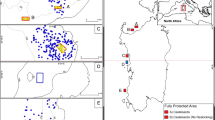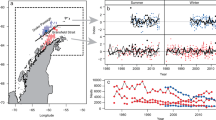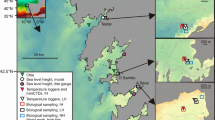Abstract
The fishery of the brown shrimp (Crangon crangon Linneaus 1758) is a widespread human activity in the coastal zone. Yet management of this fishery has never been implemented. The question is raised whether an uncontrolled fishery is sustainable or the conceivable ecological stress results in recruitment overfishing. The time series of shrimp abundance, commercial landings per unit of effort and the shrimp consumption by cod and whiting provide a perspective for nature conservation and fishery management. The results indicate that predation mortality by only two of the predator species present in the coastal areas exceeds the landings by a factor 2 to 20, and that, despite large annual fluctuations in shrimp consumption, the shrimp stock has remained remarkably stable over 30 years. Moreover, predators exploit juvenile shrimp, while the fishery exploits adult shrimp after the predators have levied their toll. The international catch of approx. 26,000 tonnes is of the same order of magnitude as the consumption of one natural predator. Thus, there is no indication that the shrimp stock is fished at unsustainable levels.
Similar content being viewed by others
References
Anonymous (in press): Interrelationship between the brown shrimp population and the multinational brown shrimp fishery (with emphasis on recent changes in the population structure). 114 pp.; Luxembourg (Eur. Commiss. DG 12 Sci., Res. and Dev.).
Beek, F. A. van &Rijnsdorp, A. D. &Clecrk, R. de (1989): Monitoring juvenile stocks in the Wadden Sea and the coastal areas of the southeastern North Sea. — Helgoländer Meeresunters.,43: 461–477.
Berghahn, R. (1996): Episodic mass invasions of juvenile gadoids into the Wadden Sea and their consequences for the population dynamics of brown shrimp (Crangon crangon). — In:Dworschak, P. C. &Stachowitsch, M. &Ott, J. A. [Eds.]: Influences of Organisms on their Environment. The Role of Episodic Events. — Pubbl. Staz. zool. Napoli I: Mar. Ecol.,17 (1/3): 251–260.
Beukema, J. J. (1992): Dynamics of juvenile shrimpCrangon crangon in a tidal-flat nursery of the Wadden Sea after mild and cold winters. — Mar. Ecol. Progr. Sen,83: 157–165.
Boddeke, R. (1968): Forecasting the landings of brown shrimps (Crangon crangon) in the Netherlands. — ICES C. M. 1968/K,8: 2 pp.
Boddeke, R. (1971): The influence of the strong 1969 and 1970 year-classes of cod on the stock of brown shrimp along the Netherlands coast in 1970 and 1971. — ICES C. M. 1971/K,32: 3 pp.
Boddeke, R. (1976): The seasonal migration of the brown shrimpCrangon crangon. — Netherl. J. Sea Res.,10: 103–130.
Boddeke, R. (1989): Management of the brown shrimp (Crangon crangon) stock in Dutch coastal waters. — In:Caddy, J. F. [Ed.] Marine Invertebrate Fisheries: Their assessment and management: 35–62; London (John Wiley & Sons).
Boddeke, R. (1996): Changes in the brown shrimp (Crangon crangon,Linné) population off the Dutch coast in relation to fisheries and phosphate discharge. — ICES J. mar. Sei.,53: 995–1002.
Boddeke, R. &Daan, N. &Posthuma, K. H. &Veen, J. F. de &Zijlstra, J. J. (1970): A census of juvenile demersal fish in the Dutch Wadden Sea, the Zeeland nursery ground, the Dutch coastal area, and the open sea area of the coasts of the Netherlands, Germany and the southern part of Denmark. — Ann. biol. Cons. int. Explor. Mer,26: 269–275.
Bohl, H. &Koura, R. (1962): Mesh selection experiments with beam trawls on shrimps (Crangon vulgaris) off the German coast. — ICES C. M. 1962/C,43: 33 pp.
Cattrijsse, A. &Dankwa, H. R. &Mees, J. (1997): Nursery function of an estuarine tidal marsh for the brown shrimpCrangon crangon. — J. Sea Res.,38: 109–121.
Daan, N. (1991): Consumption ofPandalus by MSVPA predators. — ICES C. M. 1991/K,26: 9 pp.
Del Norte-Campos, A. G. C. &Temming, A. (1998): Population dynamics of the brown shrimpCrangon crangon L., in shallow areas of the German Wadden Sea. — Fish. Management Ecol.,5: 303–322.
Heessen, H. J. L. (1983): Distribution and abundance of young cod and whiting in the south-eastern North Sea in the period 1980–1982. — ICES C. M. 1983/G,30: 4 pp.
Henderson, P. A. &Holmes, R. H. A. (1987): On the population biology of the common shrimpCrangon crangon (L.) (Crustacea: Caridea) in the Severn Estuary and Bristol Channel. — J. mar. biol. Ass. U.K.,67: 825–847.
Hostens, K. (2000): Spatial patterns and seasonality in the epi-benthic communities of the Westerschelde (Southern Bight of the North Sea). — J. mar. biol. Ass. U.K.,80: 27–36.
ICES (1985): Report of the 0-group North Sea flatfish working group. — ICES C. M. 1985/G,2: 96 pp.
ICES (1994): Report of the study group on the life history, population biology, and assessment ofCrangon. — ICES C. M. 1994/K,3: 69 pp.
ICES (1997): Report of the multispecies assessment working group. — ICES C. M. 1997/Assess,16: 235 pp.
ICES (1999): Manual for the international bottom trawl surveys. Revision VI. — ICES C. M. 1999/D,2 Addendum 2 Ref. G: 49 pp.
ICES (2000): Working group report onCrangon fisheries and life history. — ICES C. M. 2000/G,11: 28 pp.
Kühl, H. &Kuipers, B. R. (1978): Qualitative food relationships of Wadden Sea fishes. — In:Dankers, N. &Wolff, W. J. &Zijlstra, J. J. [Eds.]: Fishes and Fisheries of the Wadden Sea: 112–123; Leiden (Stichting Veth tot Steun aan Wadden onderzoek).
Kuipers, B. R. (1977): On the ecology of juvenile plaice on a tidal flat in the Wadden Sea. — Netherl. J. Sea Res.,11: 56–91.
Kuipers, B. R. &Dapper, R. (1981): Production ofCrangon crangon in the tidal zone of the Dutch Wadden Sea. — Netherl. J. Sea Res.,15: 33–53.
Kuipers, B. R. &Dapper, R. (1984): Nursery function of Wadden Sea tidal flats for the brown shrimpCrangon crangon. — Mar. Ecol. Progr. Ser.,17: 171–181.
Lissa, J. H. L.van (1977): Aantallen, voedselopname, groei en produktie van de garnaal (Crangon crangon L.) in een getijdengebied, alsmede de voedselopname en groei onder laboratoriumomstandigheden. — Intern. Rep. NIOZ,: 110pp.;Texel.
Oh, C. W. &Hartnoll, R. G. &Nash, R. D. M. (1999): Population dynamics of the common shrimp,Crangon crangon (L.), in Port Erin Bay, Isle of Man, Irish Sea. — ICES J. mar. Sei.,56: 718–733.
Pope, J. R. G. (1991): The ICES multispecies assessment working group: evolution, insights and future problems. — ICES mar. Sei. Symp.,193: 22–33.
Rijnsdorp, A. D. &Beek, F. A. van &Flatman, S. &Millner, R. M. &Riley, J. D. &Giret, M. &Clerck, R. de (1992): Recruitment of sole stocks,Solea solea (L.) in the northeast Atlantic. — Netherl. J. Sea Res.,29: 173–192.
Salz, P. &Wilde, J. W.de (1990). De roi van de garnalenvisserij voor de Nederlandse kottervloot. — Intern. Rep. LEI No. 5,81: 65 pp.
Schumacher, A. &Tiews, K. &Thomas, H. J. (1979): On the population dynamics of the brown shrimp (Crangon crangon L.) off the German coast. — Rapp. Proc.-verb. Réun. Cons. int. Explor. Mer,175: 280–386.
Temming, A. &Temming, B. (1992): Economic overfishing and increase of fishing effort in the North Sea brown shrimp fishery. — ICES C. M. 1992/K,37: 20 pp.
Tiews, K. (1970): Synopsis on biological data on the common shrimpCrangon crangon (Linneaus 1758). — FAO Fish. Rep.,57(4): 1167–1224.
Tiews, K. (1978): The predator-prey relationship between fish popultions and the stock of brown shrimp (Crangon crangon L.) in German coastal waters. — Rapp. Pro.-verb. Réun. Cons. int. Explor. de la Mer,172: 250–258.
Tiews, K. &Schumacher, A. (1982): Assessment of brown shrimp stocks (Crangon crangon L.) off the German coast for the period 1965–1978. — Arch. FischWiss.,32: 1–11.
Veer, H. W. van der &Feller, R. J. &Weber, A. &Witte, J. I. (1998): Importance of predation by crustaceans upon bivalve spat in the intertidal zone of the Dutch Wadden Sea as revealed by immunological assays of gut contents. — J. exp. mar. Biol. Ecol.,231: 139–157.
Zijlstra, J. J. (1972): On the importance of the Wadden Sea as a nursery area in relation to the conservation of the southern North Sea fishery resources. — Symp. zool. Soc. London,29: 233–258.
Author information
Authors and Affiliations
Rights and permissions
About this article
Cite this article
Welleman, H.C., Daan, N. Is the Dutch shrimp fishery sustainable?. Senckenbergiana maritima 31, 321–328 (2001). https://doi.org/10.1007/BF03043040
Received:
Revised:
Accepted:
Issue Date:
DOI: https://doi.org/10.1007/BF03043040




